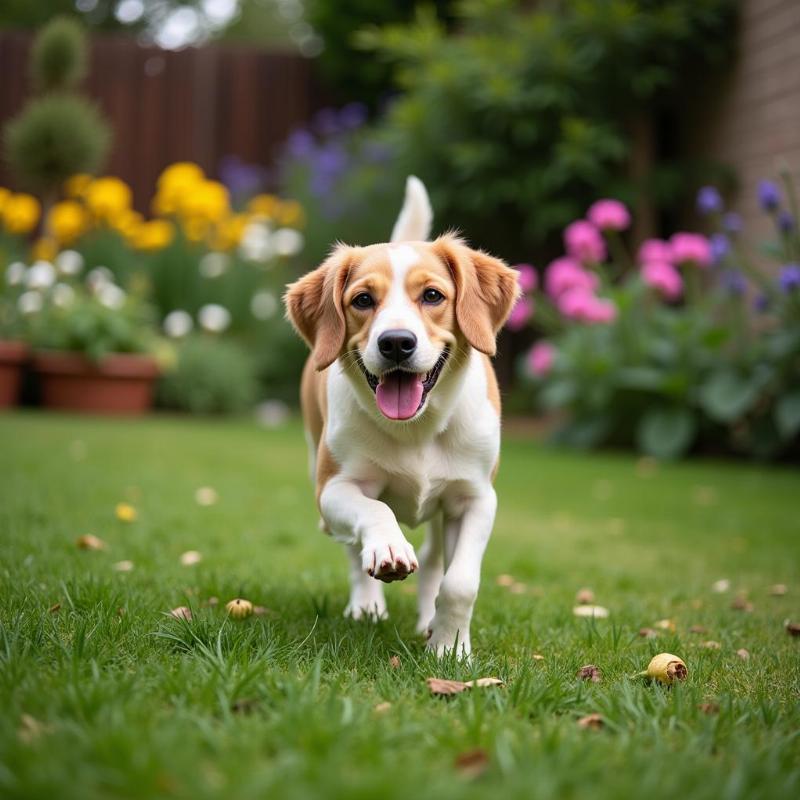If your furry friend has just chomped down on a buzzing bee, you’re likely worried. Knowing what to do if your dog eats a bee is crucial for every dog owner. This article provides a comprehensive guide to help you navigate this common canine mishap, covering everything from recognizing the symptoms to administering first aid and seeking professional veterinary care when necessary. We’ll equip you with the knowledge and resources to ensure your dog’s safety and well-being.
While a bee sting can be a painful experience for your dog, it’s usually not life-threatening. However, some dogs can have allergic reactions, making it essential to understand the signs and take appropriate action. We’ll explore the potential reactions, from mild swelling to severe anaphylaxis, and guide you on when to seek immediate veterinary attention.
Recognizing the Signs of a Bee Sting
The most common sign of a bee sting is localized swelling, typically on the face, paws, or inside the mouth. Your dog might paw at the affected area, whine, or lick excessively. If the sting is internal, such as in the mouth or throat, you might notice drooling, difficulty breathing, or changes in barking.
Identifying the Severity of the Reaction
While most bee stings cause mild discomfort, some dogs can experience more severe reactions. Watch for signs like hives, vomiting, diarrhea, weakness, or difficulty breathing. These symptoms indicate an allergic reaction and require immediate veterinary attention.
First Aid for Bee Stings in Dogs
If you can locate the stinger, try to remove it with a credit card or your fingernail, scraping it away from the skin. Avoid using tweezers, as squeezing the stinger can release more venom. Apply a cold compress to the affected area to reduce swelling and pain. You can also make a paste of baking soda and water and apply it to the sting.
Home Remedies and Over-the-Counter Medications
For mild reactions, you can give your dog Benadryl (diphenhydramine) following your veterinarian’s dosage instructions. Never administer any medication without consulting your vet first.
When to Seek Veterinary Care
If your dog exhibits signs of an allergic reaction, such as difficulty breathing, facial swelling, or hives, seek immediate veterinary care. Even if the reaction appears mild, it’s always best to err on the side of caution and contact your veterinarian for advice.
What to Expect at the Vet
Your vet may administer antihistamines, steroids, or epinephrine to manage the allergic reaction. They might also recommend keeping your dog under observation for a few hours.
Preventing Bee Stings
While completely preventing bee stings can be challenging, you can take steps to minimize the risk. Keep your dog away from flowering plants and beehives. Supervise your dog closely when outdoors, especially during warmer months when bees are most active.
Creating a Bee-Safe Environment
Consider removing bee-attracting plants from your yard and keeping garbage cans tightly sealed. Regularly check your yard for bee nests and have them professionally removed if necessary.
Conclusion
Knowing what to do if your dog eats a bee can make a significant difference in their comfort and recovery. By recognizing the signs, administering first aid, and seeking professional help when necessary, you can ensure your furry friend stays safe and healthy.
FAQ
- What should I do if my dog’s face swells up after a bee sting? Seek immediate veterinary attention, as this could be a sign of a severe allergic reaction.
- Can I give my dog human Benadryl? You can, but only after consulting with your veterinarian for the correct dosage.
- How long does the swelling from a bee sting last? Typically, the swelling subsides within a few hours to a couple of days.
- Are some dog breeds more susceptible to bee stings? No, any dog can be stung by a bee, and reactions vary based on individual sensitivity.
- What if I can’t find the stinger? Don’t worry; if you can’t locate it, focus on managing the symptoms and contacting your vet.
- Can bee stings be fatal to dogs? While rare, severe allergic reactions can be life-threatening if not treated promptly.
- How can I prevent my dog from eating bees? Supervise your dog closely outdoors, especially around flowering plants, and consider removing bee-attracting plants from your yard.
 Dog playing in the garden
Dog playing in the garden
how to dehydrate chicken for dog treats
lick mat for dogs recipe
can you marinate hot dogs
can dogs get contact high
Beautdogs.us is your trusted online resource for all things dog-related. We offer expert advice on dog breeds, care, and products, catering to both new and experienced dog owners. From nutritional guides to training tips, Beautdogs.us is your one-stop shop for comprehensive canine information. Contact us today for all your dog-related inquiries! Email: [email protected], Phone: +1 501-555-7529.